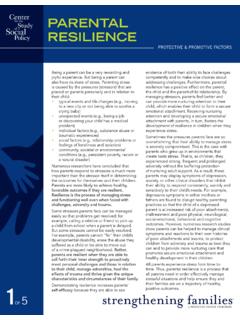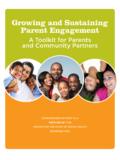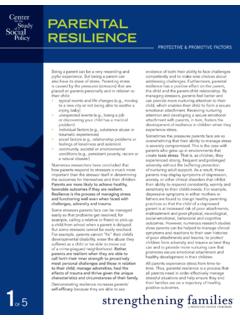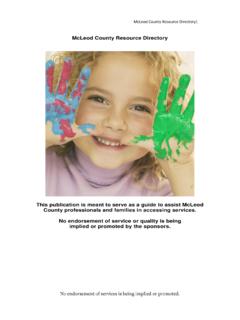Transcription of Parents’ Assessment of Protective Factors
1 parents ' Assessment of Protective Factors User's Guide and Technical Report Vonda L. Kiplinger, PhD. Charlyn Harper Browne, PhD. September 2014. This product was developed by the National Quality Improvement Center on Early Childhood (QIC-EC). The QIC-EC was funded by the Department of Health and Human Services, Administration for Children, Youth and Families, Office on Child Abuse and Neglect, under Cooperative Agreement 90CA1763. parents ' Assessment of Protective Factors Survey: User's Guide and Technical Report 2014, Center for the Study of Social Policy The Center for the Study of Social Policy (CSSP) works to secure equal opportunities and better futures for all children and families, especially those most often left behind. Underlying all of the work is a vision of child, family, and community well-being. It's a unifying framework for the many policy, systems reform, and community change activities in which CSSP engages. Center for the Study of Social Policy 1575 Eye Street, Suite 500 50 Broadway Suite 1504.
2 Washington, DC 20005 New York, NY 10004. telephone telephone fax fax This guide is in the public domain. Permission to reproduce is not necessary. Suggested citation: Kiplinger, V. L. & Harper Browne, C. (2014, September). parents ' Assessment of Protective Factors : User's guide and technical report. Washington, DC: Center for the Study of Social Policy. This guide and other documents about the National Quality Improvement Center on Early Childhood and the Strengthening Families Approach and Protective Factors Framework are available at All rights reserved. Printed in the Acknowledgements The item pool for the parents ' Assessment of Protective Factors was developed with the assistance of many individuals. First and foremost is Charlyn Harper Browne, Director of the Quality Improvement Center on Early Childhood (QIC-EC) of the Center for the Study of Social Policy (CSSP). Others on the QIC-EC leadership team also provided invaluable input into the development of the initial instrument: Judy Langford and Nilofer Ahsan, CSSP; Teresa Raphael and Martha Reeder, National Alliance of Children's Trust and Prevention Funds; Jodi Whiteman and Nancy Seibel, ZERO TO THREE; and Melissa Brodowski, Office on Child Abuse and Neglect, Children's Bureau, Administration on Children, Youth and Families, Administration for Children and Families, Department of Health and Human Services.
3 Teresa Raphael and Charlyn Harper Browne were also responsible for organizing and conducting the cognitive testing of the instrument in Olympia, Washington and Atlanta, Georgia. Ben Crosier, a doctoral student in social psychology, developed an online survey platform for one stage of the field testing process. In addition, Chelsea Humphrey and Nancy Salgado-Santos of The Connection reviewed the Spanish translations of the instrument and scoring sheet. Item pool development also benefited from the expertise of the project's Technical Advisory Committee. Members included Ed De Vos, Massachusetts School of Professional Psychology;. Jackie Counts, University of Kansas; and Christina Christie, University of California, Los Angeles. Finally, much gratitude is extended to the many parents who participated in the cognitive, pilot, and field testing of the statements in the item pool from which the field test instruments and the final instrument were constructed.
4 Their contributions were invaluable. Table of Contents 1. Conceptual Background Introduction .. 1. The Five Protective Factors .. 1. Parental Resilience .. 1. Social 2. Concrete Support in Times of Need .. 2. Social and Emotional Competence of Children .. 3. Knowledge of Parenting and Child Development .. 4. Rationale for the Development of a New Protective Factors Inventory .. 4. 2. The parents ' Assessment of Protective Factors Instrument and Composition of the Protective Factors Subscales parents ' Assessment of Protective Factors Instrument .. 6. Composition of the Protective Factors Subscales .. 6. 3. Administration and Scoring Target Population .. 8. PAPF Materials .. 8. Professional 8. Administration .. 8. General .. 8. Instructions for Parent Self-Administration .. 8. Instructions for Interviewer Administration .. 10. Missing Data .. 11. Subscale Scores and PFI Computation .. 11. Scoring .. 12. Cut Scores and Protective Factors Strengths Levels.
5 13. 4. Interpreting and Using the PAPF. An Important Reminder .. 15. Protective Factors Index and Subscale Scores .. 15. ~ ii ~. 5. Reliability and Validity 16. Validity .. 17. Face and Content Validity .. 17. Construct, Convergent and Discriminant Validity .. 17. 6. Development of the PAPF Phase 1: Inventory Development Background .. 20. Development of the Item Pool .. 21. Technical Advisory Committee Review .. 21. Cognitive Testing .. 22. Pilot Testing of the Item Pool .. 23. Amazon's Mechanical Turk (MTurk) .. 23. Pilot Test Design .. 23. MTurk Respondents .. 23. 24. Item Analyses .. 25. Exploratory Factor 25. Reliability Analyses .. 25. Differential Item Functioning and Item Bias .. 25. 26. 7. Development of the PAPF Phase 2: Instrument Development Field Test 1 .. 27. Item Selection and Instrument Design .. 27. Administration .. 28. Respondents .. 28. Psychometric Analyses .. 28. Exploratory Factor Analysis .. 29. Reliability Analyses .. 29.
6 Results .. 29. Field Test 2 .. 35. Item Selection and Instrument Design .. 35. Administration .. 36. ~ iii ~. Respondents .. 36. Psychometric Analyses .. 37. Initial Confirmatory Factor Analyses .. 37. Restricted EFA .. 39. Final CFA 43. Final First-order CFA Model .. 43. Final Second-order CFA 44. Goodness of Fit .. 45. Reliability of the Final CFA Model .. 45. Validity of the Final CFA Model .. 46. 49. Appendices Appendix A PAPF Instruments and Scoring Sheets .. 52. Appendix B Example of a Completed PAPF Scoring 65. Appendix C Existing Instruments Reviewed .. 67. Appendix D Technical Advisory Committee and Other Reviewers of the CAPF Items 69. Appendix E Instructions of Cognitive Testing of the CAPF and List of Questions for Focus Groups .. 70. Appendix F Demographic Characteristics of the MTurk Samples and the Population .. 75. Appendix G Item Statistics, Group Differences and Local Dependence of the Pilot Test Items . 76. Appendix H Recruitment Letter for First Field Test of the CAPF.
7 91. Appendix I Item Statistics, Group Differences and Local Dependence on the First Field Test .. 92. Appendix J Recruitment Letter for Second Field Test of the CAPF .. 99. Appendix K Unstandardized Parameter Estimates for the Final First-Order CFA .. 101. Appendix L Unstandardized Parameter Estimates for the Final Second-Order CFA .. 103. ~ iv ~. ~v~. Conceptual Background Introduction The Five Protective Factors The parents ' Assessment of Protective Factors The five interrelated Protective Factors are (PAPF) was developed as a measure to assess defined below along with indicators of how the presence, strength, and growth of parents ' the Factors may be observed (for additional self-reported beliefs, feelings, and behaviors details about these Protective Factors , see that are regarded as indicators of the Center for the Study of Social Policy, 2013;. Strengthening FamiliesTM Protective Factors . Harper Browne, 2014a). The items in the Please note that throughout this User's Guide PAPF reflect many of these indicators.
8 And Technical Report, the term, parent, is used to refer to an adult or adolescent who has Parental Resilience responsibility of rearing a child, including the biological parents , grandparents, other Being a parent can be a very rewarding and relatives, or non-biological caregivers. joyful experience. But being a parent can also have its share of stress. Parenting stress is The Strengthening Families Approach and caused by the pressures (stressors) that are Protective Factors FrameworkTM developed placed on parents personally and in relation to by the Center for the Study of Social Policy their child. Numerous researchers have is a research-informed, strengths-based, two- concluded that how parents respond to generation initiative to build family strengths stressors is much more important than the and a family environment that promotes stressor itself in determining the outcomes for optimal child development and reduces the themselves and their children.
9 parents are likelihood of child abuse and neglect. Five more likely to achieve healthy, favorable Protective Factors are the foundation of the outcomes if they demonstrate resilience. Strengthening Families approach. Parental Resilience is the process of Protective Factors are defined in this context as managing stress and functioning well when conditions or attributes of individuals, faced with stressors, challenges, or adversity. families, communities, or the larger society The outcome of parental resilience is personal that both mitigate risk Factors and actively growth and positive change. enhance well-being. Parental Resilience includes: The Protective Factors within the calling forth the inner strength to Strengthening Families Approach are: (a) proactively meet personal challenges and parental resilience, (b) social connections, (c) those in relation to one's child, manage concrete support in times of need, (d) adversities, and heal the effects of one's children's social and emotional competence, own early traumas and (e) knowledge of parenting and child becoming more self-confident and self- development.
10 Efficacious; believing that one can make and achieve goals not allowing stressors to keep one from providing nurturing attention to one's child ~1~. solving general life or parenting problems major stressor that inhibits parents ' ability to feeling respected and appreciated provide consistent, nurturing, responsive care having a positive attitude about life in to their children. general and about one's parenting role and responsibilities Supportive and satisfying social connections managing anger, anxiety, sadness, feelings are valuable resources that: of loneliness, and other negative feelings provide affiliative support ( , a sense of seeking help for self or child when needed community, companionship). provide emotional support ( , empathy, Social Connections affirmation of parenting skills). provide instrumental support ( , links to People need people. parents need people who jobs, transportation, financial assistance). care about them and their children, who can be provide informational support ( , good listeners, who they can turn to for well- parenting guidance, recommendations for informed advice and who they can call on for health care services).







